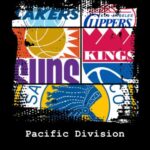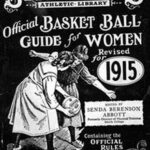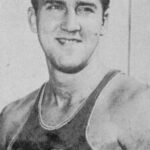The development of the one-handed jump shot takes us back to the 1930s. Back in those early days of basketball, it was considered proper form to shoot a two-handed set shot. You would put your feet fairly close together, bend at the knees, and launch the ball using both hands. It kind of looked like a chest pass toward the ceiling. You wanted a nice arc on the ball. And you would never, ever leave the floor. Your feet maintained contact with the court.
One thing that we need to remember is that the game of basketball was only around 40 years old and the things that were considered proper form back then would not be considered proper form today. One of the things that I love about basketball is that there is always someone trying to push the boundaries to find new ways of playing or new strategies to exploit. The game of basketball is never done. It’s always developing and growing.
Two-Handed Set Shot
Let us get into the two-handed set shot. The basic offense, back then, was to pass the ball around the perimeter, set screens for each other, and work to get someone a wide-open set shot. And when I say wide open, I mean WIDE OPEN. It was considered bad form to jump in order to shoot the ball. So, when you are shooting a flat-footed shot, you needed plenty of space to do so.
And without a shot clock, it could take a whole minute or more of passing the ball around before a wide-open shot presented itself. This was considered a fundamental offense. This is how all the best schools played, and all of the best schools at the time were located in and around New York City. Some of the most dominant college teams of the day were Columbia University, Manhattan University, New York University, St. Joseph’s University, City College of New York (CCNY), Fordham University, and Long Island University. Nobody questioned this style of offense since the schools who played it best were dominating the college basketball scene.
Hank Luisetti (Stanford University)
But, out West, there was one player and coach who tried something different and they found that it was working. Out at Stanford, Hank Luisetti was perfecting a one-handed running jump shot. His coach, Johnny Bunn, had designed a system that exploited Luisetti’s unique skill of being able to run, jump, and still get a shot off that went in more often than it did not.
It was an absolute revelation. This distinctive West Coast style of offense was sometimes called the Avalanche System because these teams liked playing a fast, wide-open style of basketball that was designed to overwhelm the opponent with the number of shots they took. After all, the more shots you take, the more shots you make.
In this system, Luisetti had many games where he scored in the 30s. And this was back in the days when entire teams might only score 40 points on the night. He was completely lighting up West Coast basketball.
Unfortunately, back then there was no ESPN and no nightly highlights. The only way to know what was happening on the West Coast was to read the sports section of your local newspaper two days later. Yes, you read that correctly; two days later. If a team played on the West Coast on Friday night, it would not make it into the East Coast papers on Saturday morning because of the time difference. By the time the game finished on the West Coast, the East Coast papers were already printing out Saturday morning’s edition. A typical New Yorker would not find out the results of a west coast basketball game until Sunday morning, two whole days later.
Even then, the only thing you ever knew about a player was from reading the newspaper. You had to rely on how the sportswriter described the action and then let your imagination fill in the details. Luisetti was gaining a huge reputation on the East Coast when they looked at those box scores and saw how he was torching teams, right and left.
Hank Luisetti and Stanford Come to New York
But, in late December of 1936 Stanford would go on an East Coast road trip. This was a huge deal. For the first time, East Coast basketball fans were going to be able to see this West Coast Phenom with their own eyes.
Back then Madison Square Garden was the center of college basketball. On most Saturdays, during the season the Garden would schedule double and triple headers of college games. For just a single ticket you could go to the Garden and see as many of 6 of the best teams in the country battle it out. And the college teams always wanted to play a game in the Garden because it sat nearly 18,000 people. No other arena in the country could match that back then.
So on this particular Saturday Stanford would be playing Long Island University, or LIU, in an East Coast-West Coast matchup of goliaths. LIU was on a 43-game winning streak going back two seasons. Their coach, Clair Bee, was ready to show those West Coasters how basketball is supposed to be played… the East Coast way. Well, that attitude only lasted as long as it took to have the opening tip-off. Once the game got started the LIU players had no idea what to do with Luisetti.
They didn’t know how to defend him. I mean, the guy was actually jumping to take a shot. They knew it was coming, but there was no defense for this. At the time the fundamentals of defense said that you never left your feet, no matter what. Jumping on defense was considered bad defense. So when Luisetti took off for another one-handed runner, the defender would not jump with him because that is not what a defender was supposed to do.
Luisetti was getting clean shot after clean shot. But he was not just a scorer, Luisetti could dribble and pass with the best of them. He was truly an all-around playmaker. He knew that with LIU’s defense concentrating on him he could draw defenders and pass to an open teammate.
Hank Luisetti Scores 50
Now, I wish I could tell you that Luisetti scored 50 points that night. But he didn’t. He scored 15 points in a 45-31 victory over LIU. But that was enough to turn the basketball world on its head. Mighty Long Island University and their 43-game winning streak was no more. By the standards of the day, losing by 14 points was a slaughter.
Later, Luisetti would become the first player in NCAA history to score 50 points in a single game, but what he did in the Garden on this night was more than enough to change the course of the game and cause people to rethink all of the ideas that were considered fundamental and correct.
Nat Holman, a Hall of Fame player, was coaching CCNY at the time and witnessed the game. Afterward, he said that he would quit coaching altogether before ever teaching one of his players a one-handed shot. Of course, that would change as even Holman eventually came around. The game was changing whether he liked it or not. So, eventually, he changed with it. He would later coach CCNY to the NCAA championship in 1950 where his players used the one-handed jump shot to great effectiveness.
Who Invented the Jump Shot?
Now, Luisetti did not invent the one-handed jump shot. Nobody truly knows who shot it that way first. The game was developing in all corners of the country at the same time. It would be like trying to figure out who first discovered fire. Nobody really knows. But, the basketball hall of fame unofficially acknowledges a player by the name of Glenn Roberts who used the shot to lead his high school to a Virginia state championship in 1931.
Another player named John Cooper used the one-handed jump shot at the University of Missouri in the early 1930s to great effectiveness. At the same time as Cooper, there was a guy named Conley Watts from the University of Utah who also used the shot.
But no one questions that the person who made the shot popular was Hank Luisetti. After he torched LIU on that day in Madison Square Garden, East Coast schools began to experiment with the shot. Over the next few years, every team had at least one guy who shot the ball with one hand. The two-handed set shot would quickly disappear from the game.
With most everything in life, things developed slowly and steadily as small improvements are made to whatever your thing is, like the development of the automobile or the computer. But for basketball, this was one of those times where the game took a major leap forward in a single afternoon.
As we look at some of the great jump shooters from history, guys like Jerry West, Pete Maravich, Larry Bird, Reggie Miller, and Ray Allen, they can all be traced back to Hank Luisetti. Each generation building on the techniques that came before. And now you have a guy like Steph Curry who shoots 35-foot jump shots the way other players shoot layups. I cannot wait to see what the next generation of jump shooters look like.
The game is always under development as players and coaches continue to push the boundaries of skill and strategy. If history is any indicator, then I cannot wait to see what the game looks like in another 20 or 30 years.
More From Basketball History 101
History of NBA Team Nicknames: Pacific Division
I love the history of sports team nicknames. Today I...
Read MoreCheryl Miller – Greatest Women’s Basketball Player of All Time?
Imagine that you are one of the most skilled people...
Read MoreSenda Berenson and The First Women’s Basketball Game
The very first women’s game recorded happened only one year...
Read MoreThe Mad Russian: Tom Meschery’s Extraordinary NBA Career and Unforgettable Life Story
Tom Meschery was one of the great players in Golden...
Read More


